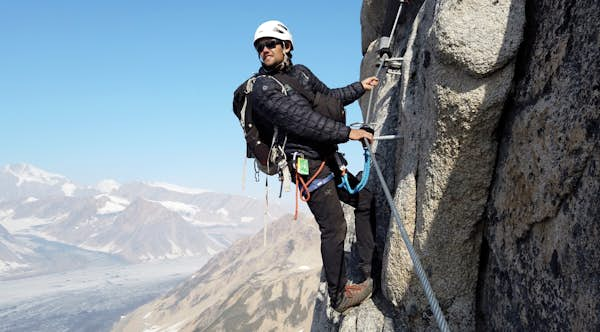Climbing’s popularity has been growing in the U.S. and around the world. Indoor climbing gyms have sprung up in nearly every state, the whole world cheered on Alex Honnold as he free-soloed El Capitan in 2017, and climbing will even be part of the 2020 Tokyo Olympics. So it comes as no surprise that via ferratas — or ‘iron paths’ in Italian — are also becoming more popular.
What is a via ferrata, exactly? It’s a protected climbing path that makes scaling a mountain easily accessible. You wear a helmet and a harness connected to bungee-like ropes with carabiners at the end and move the ropes along as you climb. The best part: no climbing experience is necessary.

Tordrillo Mountain Lodge
Alaska
While via ferratas are popular around the world, they are only just starting to become popular in the U.S. There are fewer than 10 across the nation, and Tordrillo Mountain Lodge’s is the most remote.
Alaska’s first via ferrata, a 1,200-foot iron path leading you up and down killer rock faces in the Tordrillo Mountains, will simultaneously put a big fat smile on your face. Not only does the route offer dreamy views of the Triumvirate Glacier, which spans 28 miles, you can also see Windex-colored glacial lagoons, hundreds of feet of ice and deep crevasses.
You’ll start from 4,000 feet above sea level and climb 900 vertical feet. Then, cross two suspension bridges with dizzying views down to the ice — that is, if you dare to look down.
In June, Tordrillo Mountain Lodge put the finishing touches on the climbing route, strategically located 80 miles away from the nearest road. This means only a handful of people have ever walked or climbed here. Even cooler, you can only get there via helicopter.
Back at the Lodge, rest and recover in the hot tub or at the spa, and get ready for more adventure the next day: The Lodge’s excursions include ice climbing, wake surfing, and heli-fishing in the summer. In the winter, choose from activities like heli-skiing, hiking and sky trekking.

Natura Vive’s Skylodge Adventure Suites
Sacred Valley, Peru
From rainbow-colored mountains and Machu Picchu to the worlds’ longest lefthand wave, Peru seems to have more than its fair share of natural wonders. One awesome way to experience the scenery (along with a huge dose of adrenaline) is to climb your way up a mountain in Peru’s famous Sacred Valley and spend the night in a glass pod on the side of a cliff.
Skylodge Adventure Suite’s transparent capsules are 1,200 feet off the ground, so it’s not for the faint of heart. To make it to the dreamy pods you take the via ferrata route up 1,300 feet of craggy rock where the only sounds you hear are the water rushing below and the occasional train whistle. If you’re lucky, you might even be treated to a condor sighting.
Your reward after the climb? A gourmet dinner in the dining pod and a peaceful night taking in views of the Milky Way. And no need to fret: The pods, dreamed up by adventure company Natura Vive are made from aerospace aluminum and weather resistant polycarbonate; so they are super sturdy.
In the morning, zipline your way back to terra firma and continue your adventuring through the Sacred Valley. It’s jam-packed with worthwhile stops. And Cusco and Machu Picchu are nearby, too.

Wildwire Wanaka
Wanaka, New Zealand
In Wanaka, New Zealand you can claim your title as Lord of the Rungs at Wildwire Wanaka. How? Step 1: sign up to climb the world’s tallest waterfall by via ferrata. Step 2: scale a series of nine vertical sections, cross seven bridges, sneak behind the waterfall and climb up overhangs in order to reach the top, about 1,500 feet above the valley below. Step 3: seven hours later, brag to your friends. You’ve conquered Middle Earth, and everyone must now address you as Lord of the Rungs.
The iron pathway is made of 2,500 rungs and cable that allows climbers to reach the top of Twin Falls in Wanaka, New Zealand. If you are a via ferrata newbie, opt for the Go Wild route. For intermediate climbers, try the Wild Thing route. Both are a little less intense. But if you’re brave enough to conquer Lord of the Rungs, you get a helicopter ride back to the ground.

Kent Mountain Adventure Center
Estes Park, Colorado
Kent Mountain Adventure Center has an epic via ferrata route with insane views of Rocky Mountain National Park and Estes Park. It’s part scrambling, part technical climbing. The first half of the adventure will have you shimmying across an exposed cliff. The second portion is a ridge section. Thanks to ladders, steel steps, natural rock features and cables, pretty much anyone can make it up the 600-foot cliff. Requirements: A decent fitness level and the ability to deal with heights.
For an extra dose of adventure, rappel down to a nylon cot no bigger than two sleeping bags (called a portaledge) and spend the night on the side of a cliff. While cliff camping, keep your eyes peeled for peregrine falcons, and don’t be surprised if a hummingbird comes along.
Chow down on a well-deserved cliffside dinner and soak up views of the 14,259-foot Longs Peak, Jurassic Park (a series of gorgeous domes) and Mummy Range. With so much beauty and unreal topography, it’s easy to see why people flock here. In the morning, rappel back down.

Projet Vertical
Quebec, Canada
About a 30-minute drive from Québec City is Project Vertical, which has several via ferrata routes and a zip line over the Sainte-Anne Canyon, an unbelievable steep-sided gorge. Begin by clipping into a cable system and following the rock formation to get to the Giant’s Pothole, then tred carefully across a monkey bridge to get to the waterfall.
Choose from beginner, intermediate or expert level. Even children as young as 6 years old can participate.
